Evangelos Marinakis’ Capital Product Partners is waging an important transformation into a pure-play owner of LNG carriers, a transition that will require the disposal of a 15-strong fleet of container ships.
But accompanying the high-profile inflow and outflow of vessels is a subtler segue: Capital is dumping the master limited partnership (MLP) model it has embraced since its outset in favour of becoming a traditional “C Corporation”.
The question might be asked: “What took them so long?”
And that has less to do with the LNG part than it does the MLP aspect.
Capital is one of the few remaining shipping MLPs, and that is for a reason. After a promising start in the early 2000s through companies such as Teekay and Overseas Shipholding Group, MLPs over time have proved to be untenable in the shipping space.
Their overall failure has been a testament to the volatility of shipping even in sectors presumed to be largely stable and predictable in their long-term revenue streams.
An MLP is a hybrid legal entity that combines elements of two business structures — a partnership and a corporation.
MLPs have two types of partners: general partners, who manage the MLP and oversee its operations, and limited partners, who are investors in the MLP. They are considered low-risk, long-term investments, providing a slow but steady income stream — that is when everything goes to plan.
The structure came to shipping largely out of the energy industry, often used in pipeline projects.
Evercore ISI analyst Jonathan Chappell has covered shipping since 2001 and saw the first shipping versions of MLPs in real-time. While he no longer covers Capital Product Partners, he wrote about the company for more than a decade.
“The contract durations for most shipping segments, primarily tanker and dry in bulk, were never long enough to ensure perpetual payments of dividends,” Chappell told Streetwise this week.
“Once ‘long-term’ contracts (3-, 5-, 7-years) ended, the vessels and cash flows were prone to wherever the segment was in the cycle. Usually with bad results.”
Even MLPs done in the gas sector, where contracts typically ranged from seven to 10 years, did not prove to have the necessary duration, Chappell said, falling well short of the 15 to 25-year span of a true energy MLP.
“And even when those [energy contracts] ended, the underlying end markets were not nearly as volatile as those for shipping,” Chappell noted.
So when markets went bust for shipping MLPs, a vicious circle ensued. Companies were forced to reduce or eliminate the so-called “safe” distributions, which then tanked the stock price, sending the outfit into a downward spiral.
As Chappell suggested, the model was fraught even in the gas sector. Poor public valuations left MLPs vulnerable to take-private initiatives from private equity, with Teekay LNG, Hoegh LNG and GasLog Partners among those to disappear.
GasLog Partners was trading at only 58% of net asset value and Hoegh LNG at 59% when taken private at levels that offered a premium to those levels, but it was still sitting below NAV, according to a presentation from Evercore investment banker Mark Friedman last November.
Other MLPs that have remained public have done so in name only: for example, Navios Maritime Partners, which has maintained the structure but long ago slashed its distribution to limited partners.
“Generally they are not vehicles that institutional investors will own, and for a long time the MLPs have traded at big discounts,” said analyst Ben Nolan of Stifel.
“They do give the sponsors much more control, but that is another reason institutions don’t like them.”
What does this all mean for Marinakis and Capital? Streetwise reached out to the company for comment but did not receive a reply by the deadline.
However, chief executive Jerry Kalogiratos discussed the structure on the company’s recent earnings call.
“Now with regard to … the distribution or the capital allocation policy, I think that’s probably where you should expect also to see changes. The MLP model is more rigid in a way with asset distribution and moving from there onwards,” Kalogiratos told equity analysts.

“I think the details of that are going to be carved out once we have completed the conversion of the partnership [to] corporation.”
Where is this likely to lead? Towards an improved stock valuation, as Nolan told clients in a recent research note.
“We are assuming an 8x multiple which is higher than CPLP had traditionally been valued. The fleet will be nearly brand new and obviously still growing, but also because we believe there should be upside as the business is converted into a corporation,” Nolan wrote, referring to Capital Product Partners by its ticker.
The closest comparable peer will be Flex LNG, which trades at a multiple of 10 times the ratio of enterprise value to Ebitda.
“While we expect it is likely to take time for CPLP to trade to at similar multiples given the lower free float, we do believe there could be appreciation as the corporate structure changes,” Nolan wrote.
More ship finance news
Harry Vafias venture C3is intends to raise about $6m in an equity issue to finance future vessel purchases. The Nasdaq-listed company aims to sell shares and warrants, according to a US securities filing. Click here to read.
Stolt-Nielsen’s swoop for more Odfjell stock has brought the question of a chemical tanker mega-merger back into the spotlight. Click here to read.
Major US-based institutional investor BlackRock has added exposure to product tanker giant Scorpio Tankers over the past year while cutting its position in smaller peer Ardmore Shipping by more than a quarter. Click here to read.




